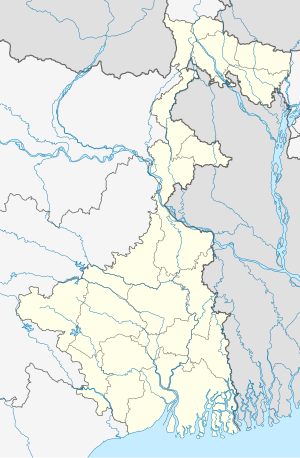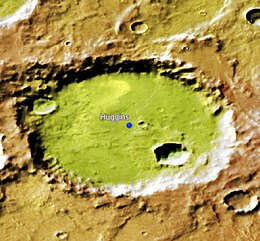HR 3159
HR 3159| 관측 데이터 Epoch J2000.00 이쿼녹스 J2000.00 | |
|---|---|
| 별자리 | 카리나 |
| 우측 상승 | 08h 00m 19.96678s[1] |
| 탈위임 | −63° 34′ 02.8420″[1] |
| 겉보기 크기 (V) | 4.81[2] |
| 특성. | |
| 스펙트럼형 | B4V[3] |
| B-V색지수 | −0.173±0.007[2] |
| 아스트로메트리 | |
| 방사 속도 (Rv) | +22.1±2.8km[2]/s |
| 고유 운동 (μ) | RA: −1.89[1]mas/yr Dec.: 19.21마스[1]/yr |
| 시차 (π) | 6.53 ± 0.13[1] 마스 |
| 거리 | 499 ± 10 리 (102 ± 3 pc) |
| 절대치수 (MV) | −1.11[2] |
| 세부 사항 | |
| 미사 | 6.3±0.1[4] M☉ |
| 반지름 | 3.77±0.27[5] R☉ |
| 루미도 | 912[6] L☉ |
| 표면 중력 (log g) | 4.03±0.05[5] cgs |
| 온도 | 16,983[6] K |
| 금속성 [Fe/H] | −0.09±0.06[7] 덱스를 만들다 |
| 회전 속도 (v sin i) | 시속 43km[6] |
| 나이 | 17.2±1.3 또는[4] 176Myr[8] |
| 기타 지정 | |
| 데이터베이스 참조 | |
| 심바드 | 자료 |
HR 3159는 카리나의 남쪽 별자리에 있는 단일[10] 항성으로, 볼란스와의 남쪽 별자리 경계 근처에 위치한다.Bayer 명칭 D Carinae가 있으며, HR 3159는 Bright Star Catalogue 명칭이다.이 물체는 청백색을 띠며 육안으로 볼 수 있으며, 가시적 크기는 +4.81이다.[2]시차를 기준으로 태양으로부터 약 499광년 거리에 위치해 있으며,[1] 22km/s의 방사형 속도로 더 멀리 떠내려가고 있다.
이 물체는 B형 주계열성으로, B4V의 별 분류를 통해 핵심 수소융합을 진행 중임을 알 수 있다.[3]이 별의 반지름은 태양 반지름의 거의 4배,[5] 그리고 태양 질량의 6배가[4] 넘는다.나이 추정치는 1700만년에서[4] 1억7600만년까지이며[8], 43km/s의 예상 회전 속도로 회전하고 있다.[6]유효온도 16,983 K로 광권으로부터 태양의 912배의[6] 광도를 방출하고 있다.[6]
참조
- ^ a b c d e f van Leeuwen, F. (November 2007), "Validation of the new Hipparcos reduction", Astronomy and Astrophysics, 474 (2): 653–664, arXiv:0708.1752, Bibcode:2007A&A...474..653V, doi:10.1051/0004-6361:20078357, S2CID 18759600.
- ^ a b c d e Anderson, E.; Francis, Ch. (2012), "XHIP: An extended hipparcos compilation", Astronomy Letters, 38 (5): 331, arXiv:1108.4971, Bibcode:2012AstL...38..331A, doi:10.1134/S1063773712050015, S2CID 119257644.
- ^ a b Houk, Nancy (1978), Michigan catalogue of two-dimensional spectral types for the HD stars, vol. 1, Ann Arbor: Dept. of Astronomy, University of Michigan, Bibcode:1975mcts.book.....H.
- ^ a b c d Tetzlaff, N.; et al. (January 2011), "A catalogue of young runaway Hipparcos stars within 3 kpc from the Sun", Monthly Notices of the Royal Astronomical Society, 410 (1): 190–200, arXiv:1007.4883, Bibcode:2011MNRAS.410..190T, doi:10.1111/j.1365-2966.2010.17434.x, S2CID 118629873.
- ^ a b c Fitzpatrick, E. L.; Massa, D. (March 2005), "Determining the Physical Properties of the B Stars. II. Calibration of Synthetic Photometry", The Astronomical Journal, 129 (3): 1642–1662, arXiv:astro-ph/0412542, Bibcode:2005AJ....129.1642F, doi:10.1086/427855, S2CID 119512018.
- ^ a b c d e f Balona, L. A.; et al. (May 2019), "Rotational modulation in TESS B stars", Monthly Notices of the Royal Astronomical Society, 485 (3): 3457–3469, arXiv:1902.09470, Bibcode:2019MNRAS.485.3457B, doi:10.1093/mnras/stz586.
- ^ Gáspár, András; et al. (2016), "The Correlation between Metallicity and Debris Disk Mass", The Astrophysical Journal, 826 (2): 171, arXiv:1604.07403, Bibcode:2016ApJ...826..171G, doi:10.3847/0004-637X/826/2/171, S2CID 119241004.
- ^ a b Gontcharov, G. A. (November 2012), "Spatial distribution and kinematics of OB stars", Astronomy Letters, 38 (11): 694–706, arXiv:1606.09028, Bibcode:2012AstL...38..694G, doi:10.1134/S1063773712110035, S2CID 119108982.
- ^ "HD 66591". SIMBAD. Centre de données astronomiques de Strasbourg. Retrieved 2019-12-04.
- ^ Eggleton, P. P.; Tokovinin, A. A. (2008), "A catalogue of multiplicity among bright stellar systems", Monthly Notices of the Royal Astronomical Society, 389 (2): 869, arXiv:0806.2878, Bibcode:2008MNRAS.389..869E, doi:10.1111/j.1365-2966.2008.13596.x, S2CID 14878976.


